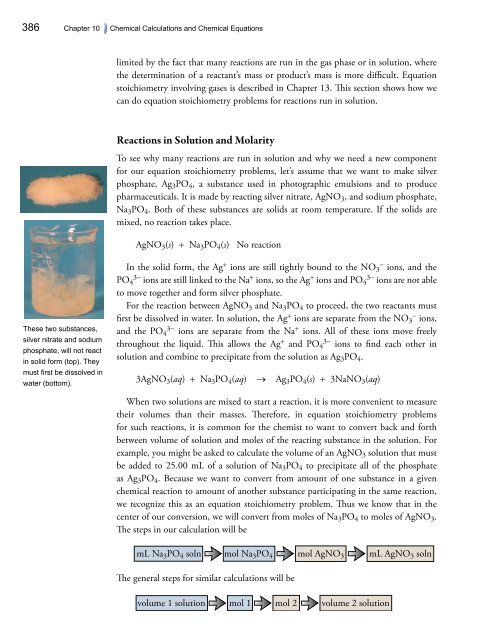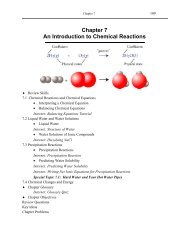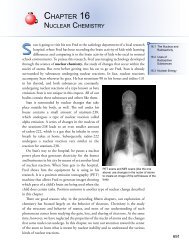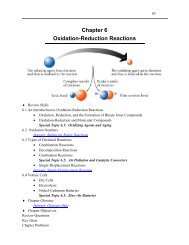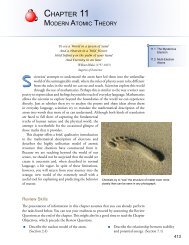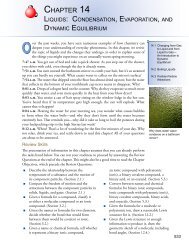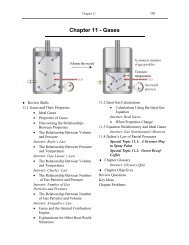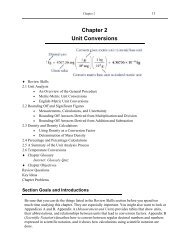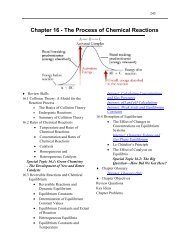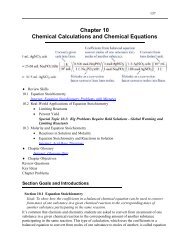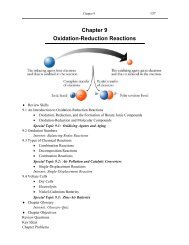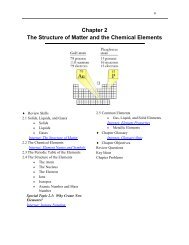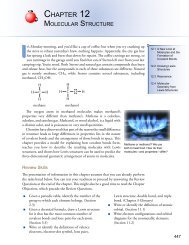Chapter 10 - An Introduction to Chemistry: Chemical Calculations ...
Chapter 10 - An Introduction to Chemistry: Chemical Calculations ...
Chapter 10 - An Introduction to Chemistry: Chemical Calculations ...
You also want an ePaper? Increase the reach of your titles
YUMPU automatically turns print PDFs into web optimized ePapers that Google loves.
386 <strong>Chapter</strong> <strong>10</strong> <strong>Chemical</strong> <strong>Calculations</strong> and <strong>Chemical</strong> Equations<br />
limited by the fact that many reactions are run in the gas phase or in solution, where<br />
the determination of a reactant’s mass or product’s mass is more difficult. Equation<br />
s<strong>to</strong>ichiometry involving gases is described in <strong>Chapter</strong> 13. This section shows how we<br />
can do equation s<strong>to</strong>ichiometry problems for reactions run in solution.<br />
Reactions in Solution and Molarity<br />
To see why many reactions are run in solution and why we need a new component<br />
for our equation s<strong>to</strong>ichiometry problems, let’s assume that we want <strong>to</strong> make silver<br />
phosphate, Ag 3 PO 4 , a substance used in pho<strong>to</strong>graphic emulsions and <strong>to</strong> produce<br />
pharmaceuticals. It is made by reacting silver nitrate, AgNO 3 , and sodium phosphate,<br />
Na 3 PO 4 . Both of these substances are solids at room temperature. If the solids are<br />
mixed, no reaction takes place.<br />
AgNO 3 (s) + Na 3 PO 4 (s) No reaction<br />
These two substances,<br />
silver nitrate and sodium<br />
phosphate, will not react<br />
in solid form (<strong>to</strong>p). They<br />
must first be dissolved in<br />
water (bot<strong>to</strong>m).<br />
In the solid form, the Ag + ions are still tightly bound <strong>to</strong> the NO 3<br />
-<br />
ions, and the<br />
PO 4<br />
3-<br />
ions are still linked <strong>to</strong> the Na + ions, so the Ag + ions and PO 4<br />
3-<br />
ions are not able<br />
<strong>to</strong> move <strong>to</strong>gether and form silver phosphate.<br />
For the reaction between AgNO 3 and Na 3 PO 4 <strong>to</strong> proceed, the two reactants must<br />
first be dissolved in water. In solution, the Ag + ions are separate from the NO 3<br />
-<br />
ions,<br />
and the PO 4<br />
3-<br />
ions are separate from the Na + ions. All of these ions move freely<br />
throughout the liquid. This allows the Ag + and PO 4<br />
3-<br />
ions <strong>to</strong> find each other in<br />
solution and combine <strong>to</strong> precipitate from the solution as Ag 3 PO 4 .<br />
3AgNO 3 (aq) + Na 3 PO 4 (aq) → Ag 3 PO 4 (s) + 3NaNO 3 (aq)<br />
When two solutions are mixed <strong>to</strong> start a reaction, it is more convenient <strong>to</strong> measure<br />
their volumes than their masses. Therefore, in equation s<strong>to</strong>ichiometry problems<br />
for such reactions, it is common for the chemist <strong>to</strong> want <strong>to</strong> convert back and forth<br />
between volume of solution and moles of the reacting substance in the solution. For<br />
example, you might be asked <strong>to</strong> calculate the volume of an AgNO 3 solution that must<br />
be added <strong>to</strong> 25.00 mL of a solution of Na 3 PO 4 <strong>to</strong> precipitate all of the phosphate<br />
as Ag 3 PO 4 . Because we want <strong>to</strong> convert from amount of one substance in a given<br />
chemical reaction <strong>to</strong> amount of another substance participating in the same reaction,<br />
we recognize this as an equation s<strong>to</strong>ichiometry problem. Thus we know that in the<br />
center of our conversion, we will convert from moles of Na 3 PO 4 <strong>to</strong> moles of AgNO 3 .<br />
The steps in our calculation will be<br />
mL Na 3 PO 4 soln<br />
mol Na 3 PO 4 mol AgNO 3<br />
mL AgNO 3 soln<br />
The general steps for similar calculations will be<br />
volume 1 solution<br />
mol 1 mol 2<br />
volume 2 solution


